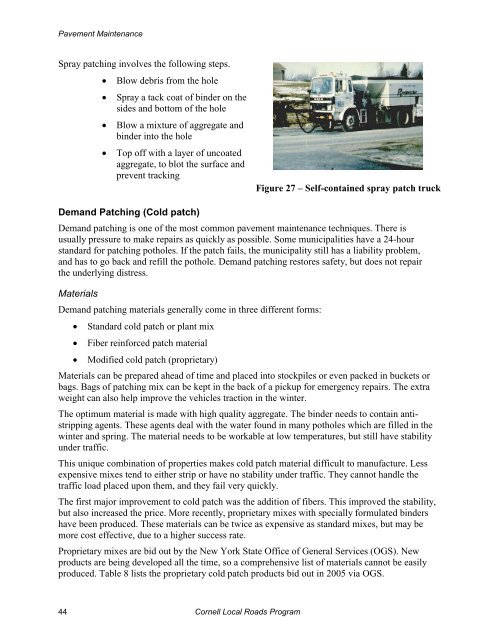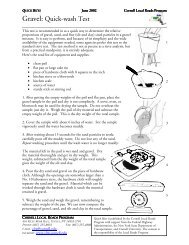Pavement Maintenance - Cornell Local Roads Program - Cornell ...
Pavement Maintenance - Cornell Local Roads Program - Cornell ...
Pavement Maintenance - Cornell Local Roads Program - Cornell ...
You also want an ePaper? Increase the reach of your titles
YUMPU automatically turns print PDFs into web optimized ePapers that Google loves.
<strong>Pavement</strong> <strong>Maintenance</strong><br />
Spray patching involves the following steps.<br />
• Blow debris from the hole<br />
• Spray a tack coat of binder on the<br />
sides and bottom of the hole<br />
• Blow a mixture of aggregate and<br />
binder into the hole<br />
• Top off with a layer of uncoated<br />
aggregate, to blot the surface and<br />
prevent tracking<br />
Demand Patching (Cold patch)<br />
Demand patching is one of the most common pavement maintenance techniques. There is<br />
usually pressure to make repairs as quickly as possible. Some municipalities have a 24-hour<br />
standard for patching potholes. If the patch fails, the municipality still has a liability problem,<br />
and has to go back and refill the pothole. Demand patching restores safety, but does not repair<br />
the underlying distress.<br />
Materials<br />
Demand patching materials generally come in three different forms:<br />
• Standard cold patch or plant mix<br />
• Fiber reinforced patch material<br />
• Modified cold patch (proprietary)<br />
Materials can be prepared ahead of time and placed into stockpiles or even packed in buckets or<br />
bags. Bags of patching mix can be kept in the back of a pickup for emergency repairs. The extra<br />
weight can also help improve the vehicles traction in the winter.<br />
The optimum material is made with high quality aggregate. The binder needs to contain antistripping<br />
agents. These agents deal with the water found in many potholes which are filled in the<br />
winter and spring. The material needs to be workable at low temperatures, but still have stability<br />
under traffic.<br />
This unique combination of properties makes cold patch material difficult to manufacture. Less<br />
expensive mixes tend to either strip or have no stability under traffic. They cannot handle the<br />
traffic load placed upon them, and they fail very quickly.<br />
The first major improvement to cold patch was the addition of fibers. This improved the stability,<br />
but also increased the price. More recently, proprietary mixes with specially formulated binders<br />
have been produced. These materials can be twice as expensive as standard mixes, but may be<br />
more cost effective, due to a higher success rate.<br />
Proprietary mixes are bid out by the New York State Office of General Services (OGS). New<br />
products are being developed all the time, so a comprehensive list of materials cannot be easily<br />
produced. Table 8 lists the proprietary cold patch products bid out in 2005 via OGS.<br />
44 <strong>Cornell</strong> <strong>Local</strong> <strong>Roads</strong> <strong>Program</strong><br />
Figure 27 – Self-contained spray patch truck





